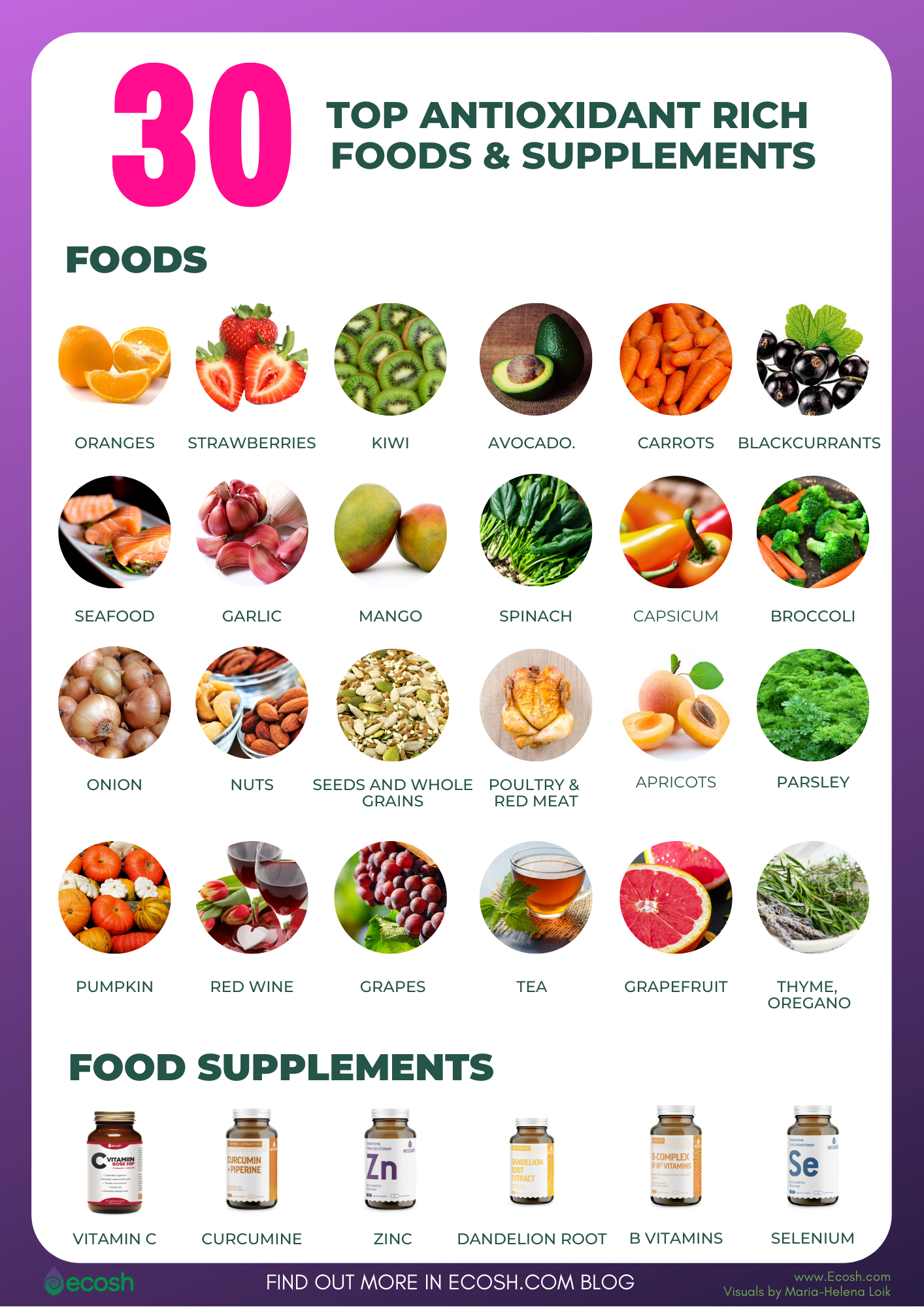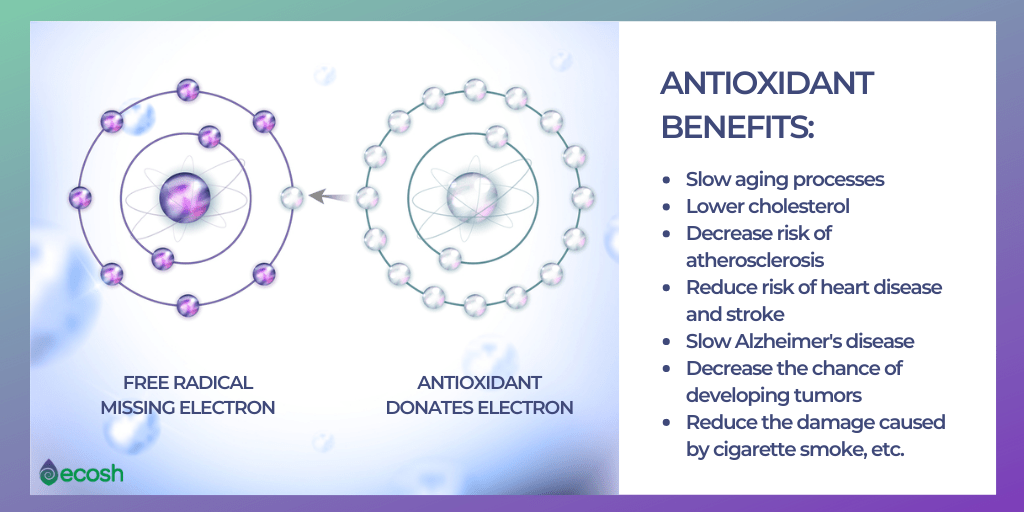OXIDATIVE STRESS - SYMPTOMS, CAUSES, COMPLICATION, AND FOODS TO FIGHT OXIDATIVE STRESS NATURALLY
Oxidative stress is a disproportion between antioxidants and free radicals (known as reactive oxygen species (ROS)) in your body. Free radicals are chemical compounds developed by oxidation, for instance, as by-products of metabolism.
Your body generates free radicals as a response to environmental and other forces, as the body processes food and responds to the environment.
Therefore, it is absolutely ordinary to have some free radicals in your body.
However, free radicals are oxygen-containing unsteady atoms with an unequal number of electrons which lets them to effortlessly react with other different atoms. What's more, since free radicals react with other atoms so simply - they can cause enormous chain reactions in your body.
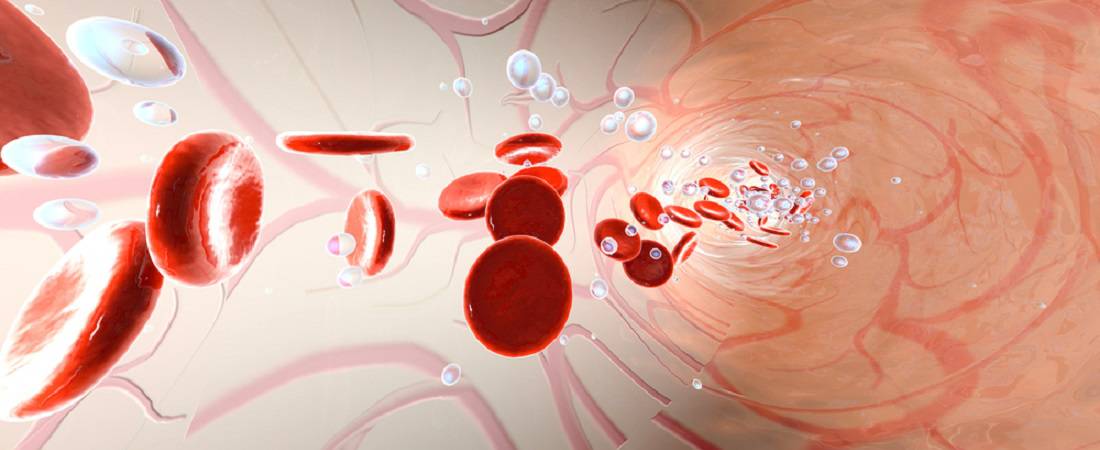
These reactions are called oxidation, and it is a normal and necessary process that takes place in your body. However, when there’s an imbalance between free radical action and antioxidant action, oxidative stress may take place.
When the share of free radicals in the body escalates remarkably and, due to their excessive activity, will instead begin to assault and damage the body's own cells. These injured cells, in turn, create new free radicals.
However, on the other hand, antioxidants are particles that can donate an electron to a free radical. This kind of donation makes the free radical stable and less reactive.
In conclusion, if your body can't get rid of free radicals efficiently, oxidative stress may follow, and this can injure cells and body functions that lead to an overall aging of the body.
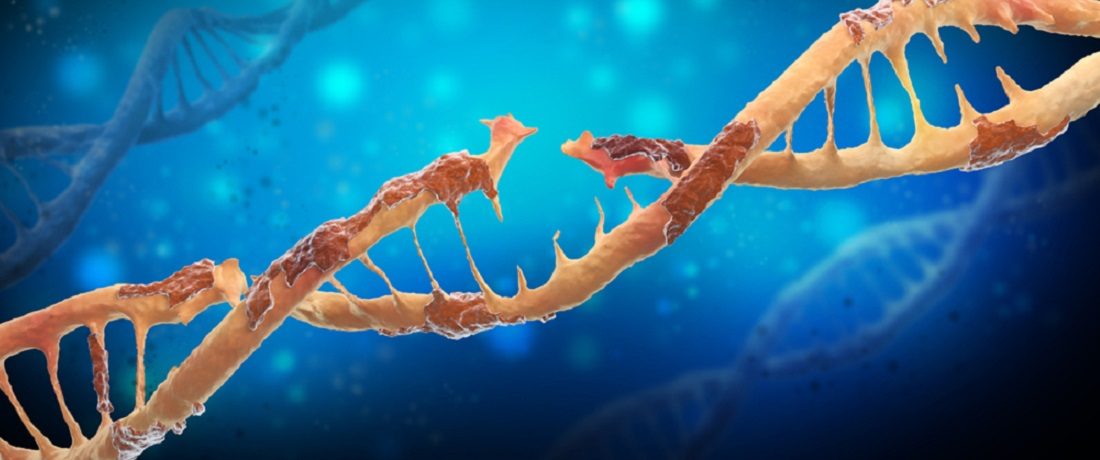
Free Radicals
Free radicals are totally ordinary side-effects of dealing with biochemical reactions in the body, including immune responses and normal metabolic procedures.
These radicals are exceptionally unsteady atoms that have electrons accessible to respond with different natural substrates, for example DNA, proteins and lipids. Free radicals include:
- Hydroxyl (OH•)
- Superoxide (O2•–)
- Nitric oxide (NO•)
- Nitrogen dioxide (NO2•)
- Neroxyl (ROO•)
- Lipid peroxyl (LOO•)
- Also, hydrogen peroxide (H2O2), ozone (O3), singlet oxygen (1O2), hypochlorous acid (HOCl), nitrous acid (HNO2), peroxynitrite (ONOO–), dinitrogen trioxide (N2O3), lipid peroxide (LOOH), which are not free radicals and generally called oxidants, but can easily lead to free radical reactions in living organisms.
Substances that can elevate the amount of free radicals may be found all around us - in the food, in the drugs and medicines, in the water, and in the air.
Free radicals may lead to demolition to parts of cells (cell membranes, proteins and DNA) when taking their electrons. The stealing process is called oxidation. Therefore, the damage caused by free radicals is also called “oxidative damage” or "oxidative stress".
At the point when free radicals steal significant parts of the cell, those parts lose their capacity to work properly, and the build-up of such harm may result in cell death. In conclusion, aggravated action of free radicals may cause or increase cell injury and induce diseases.
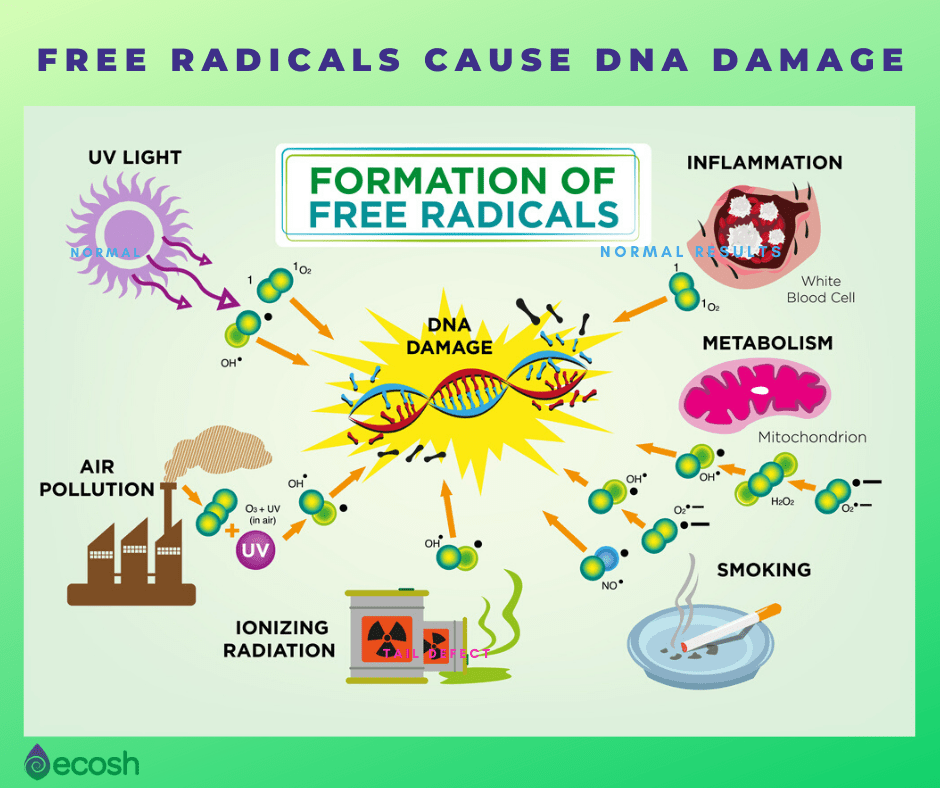
The Causes of a Dangerous Increase of Free Radicals and Oxidative Stress
The growth of free radicals may be threatening, but antioxidants can defend against the cell injury that free radicals cause (oxidative stress).
However, the protective system of antioxidants may be weak because of sickness, aging, small amounts of antioxidants in food, and poor intake. Factors that boost the creation of free radicals in the body can be internal, or external.
Internal causes of the high free radical level in the body that can lead to cell damage and oxidative stress include:
- Mitochondrial activity.
- Inflammation.
- Tissue trauma, due to inflammation and injury.
- Ischemia and reperfusion damage.
- Stress.
- Infectious and chronic diseases.
- High internal toxin level.
- Age.
- Obesity.
External causes of the high free radical level in the body that can lead to cell damage and oxidative stress include:
- Consumption of certain foods, especially fried, refined and processed foods, trans fats, artificial sweeteners, food containing carcinogens, and certain dyes and additives.
- Excessive exercise.
- Smoking.
- UV exposure, and cigarette smoke.
- Environmental toxins and pollution.
- Radiation.
- Exposure to chemicals, such as pesticides and drugs, including chemotherapy, and the consumption of skincare products that contain high amounts of parabens and other chemicals.
- Industrial solvents.
- Alcohol.
- Some medications.
- In addition, low levels of antioxidants in food.
In conclusion, all these factors that cause increased free radical level can lead to cell damage and oxidative stress. However, it is believed that intake of antioxidants reduces these risks.
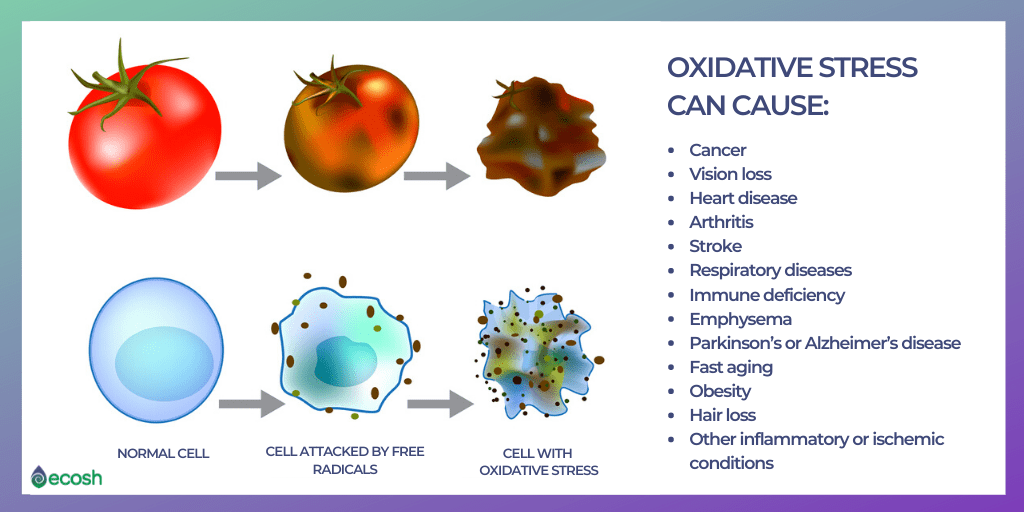
Oxidative Stress Symptoms
How do you find out that you may suffer from oxidative stress? Here are a some symptoms to pay attention:
- Wrinkles and grey hair
- Decreased eyesight
- Fatigue
- Memory loss and/or brain fog
- Muscle and/or joint pain
- Headaches and sensitivity to noise
- Susceptibility to infections
Damage and Diseases Caused by Free Radicals and Oxidative Stress
Oxidative stress is associated with significant decline in the efficacy of antioxidant defenses or elevated creation of oxidizing species. Therefore, the seriousness of the oxidative stress depends upon the cells capability to overcome this disturbance and come back to its original state.
Even moderate oxidation may trigger apoptosis, and extreme oxidative stress can cause cell death and necrosis.
In other words, when there are excessive free radicals in your body, the free radicals can start damaging DNA, proteins, and fatty tissue in your body. All these (DNA, proteins and lipids) make up a huge part of your body, so the destruction of free radicals can accelerate aging, and cause a variety of diseases.
Oxidative stress also is likely to be involved in age-related development of cancer.
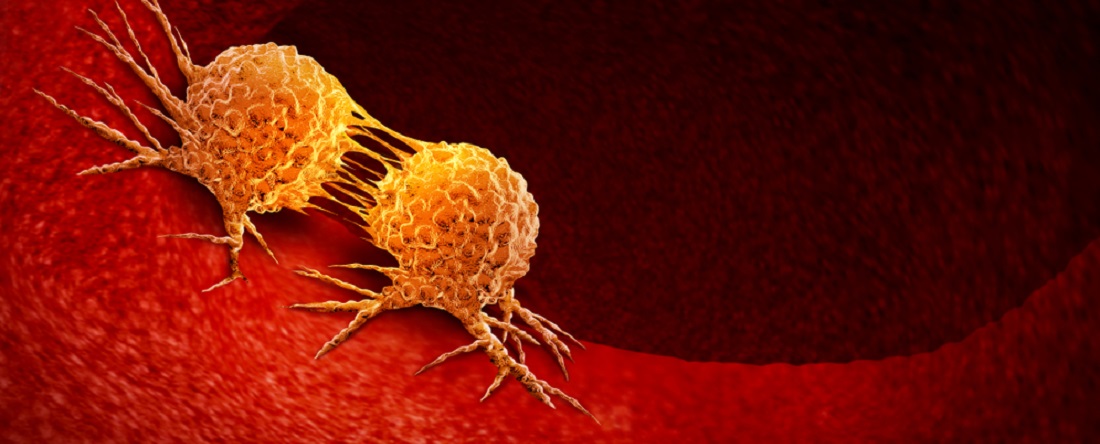
Oxidative stress and the damage of free radicals has been linked to:
- Cancer - certain cancers are triggered by damaged cell DNA.
- Atherosclerosis.
- Vision loss - deterioration of the eye lens, which contributes to blindness.
- Heart disease - increased risk of coronary heart disease, since free radicals encourage low-density lipoprotein (LDL) cholesterol to stick to artery walls.
- Arthritis - inflammation of the joints.
- Stroke.
- Respiratory diseases.
- Immune deficiency.
- Emphysema.
- Parkinson’s disease - damage to nerve cells in the brain, which contributes to this condition.
- Alzheimer’s disease - also damage to nerve cells in the brain.
- Obesity.
- Hair loss and gray hair.
- Fast aging - acceleration of the ageing process.
- An excessive release of free iron or copper ions.
- A disruption of electron transport chains.
- An increase in enzymes that generate free radicals.
- Inflammatory joint disease.
- Asthma.
- Diabetes.
- Senile dementia.
- In addition, other inflammatory or ischemic conditions.
It is believed that the free radicals cause mutations in the cells that may lead to these and probably also other health conditions. However, antioxidants aid to offset free radicals, which also improves our overall health.
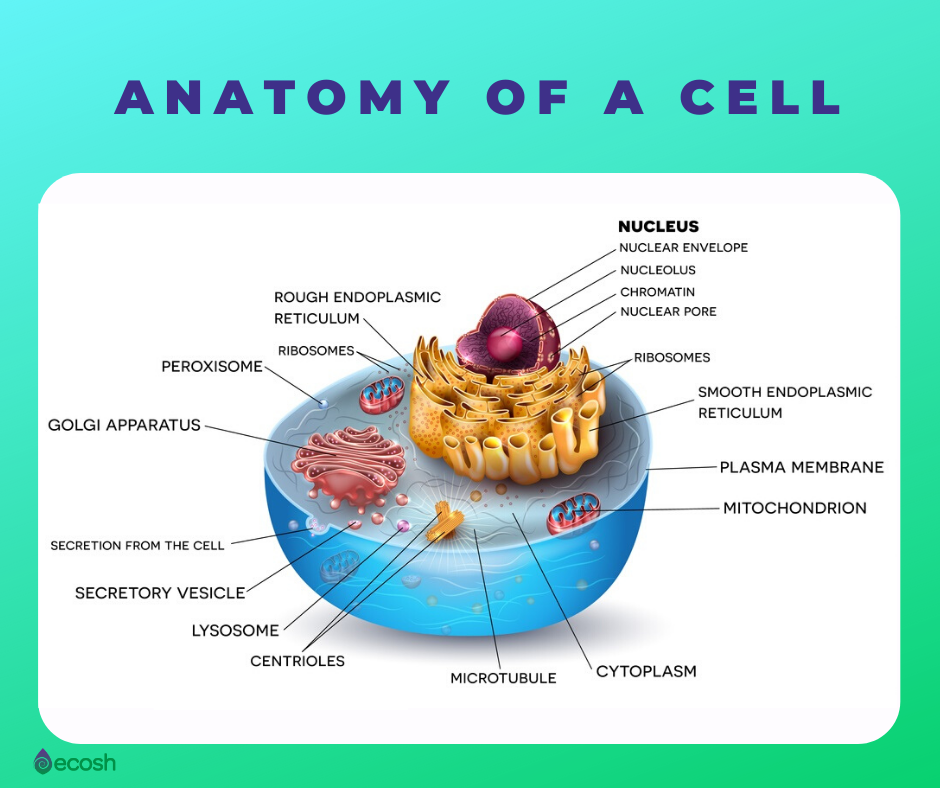
Antioxidants Help Against Free Radicals and Oxidative Stress
Antioxidants are substances that prevent and manage the formation of free radicals, and inhibit or slow down the injury to cells caused by free radicals.
So, because of that antioxidants are sometimes also called “free-radical scavengers.”
The sources of antioxidants can be natural or artificial. Your body also generates some antioxidants, known as endogenous antioxidants. Antioxidants that originate outer the body are named exogenous.
In conclusion, each antioxidant serves a separate task and is not replaceable with another. Therefore, it is extremely vital to have a varied diet.
Remedies To Fight Oxidative Stress Naturally - Antioxidant-Rich Foods And Dietary Supplements
Foods and substances that have antioxidant properties that come from outside the body (exogenous) include:
- Vitamins such as Vitamin A, C, E, Q, N (alpha-lipoic acid), P (bioflavonoids), B1, B3, B6, B9:
- A – liver, sweet potatoes, carrots, milk, and egg yolks
- C – oranges, blackcurrants, kiwifruit, mangoes, broccoli, spinach, capsicum and strawberries
- E – vegetable oils (such as wheat germ oil), avocados, nuts, seeds and whole grains
- B Group Vitamins - include meat (especially liver), seafood, poultry, eggs, dairy products, legumes, leafy greens, seeds and fortified foods, such as breakfast cereal and nutritional yeast.
- Minerals such as selenium (Se), zinc (Zn), manganese (Mn), and copper (Cu):
- Selenium – seafood, offal, lean meat and whole grains
- Zinc – seafood, lean meat, milk and nuts
- Manganese – seafood, lean meat, milk and nuts
- Copper – seafood, lean meat, milk and nuts
- Beta-carotene (β-Carotene) – pumpkin, mangoes, apricots, carrots, spinach and parsley
- Amino acids such as glutamine, histidine, methionine
- Hormones such as melatonin, estradiol
- Glutathione - turmeric
- Carotenoids and Bioflavonoids - These are phytonutrients containing in plant food, that give fruits and vegetables color and flavor
- Flavonoids, Flavones, Catechins, Polyphenols, and Phytoestrogens are all types of antioxidants and phytonutrients found also in plant-based foods.
- Lycopene
- Lutein – green, leafy vegetables like spinach, and corn
- Zeaxanthin
- Flavonoids – tea, green tea, citrus fruits, red wine, onion and apples
- Allium sulphur compounds – leeks, onions and garlic
- Anthocyanins – eggplant, grapes and berries
- Catechins – red wine and tea
- Cryptoxanthin – red capsicum, pumpkin and mangoes
- Indoles – cruciferous vegetables such as broccoli, cabbage and cauliflower
- Isoflavonoids – soybeans, tofu, lentils, peas and milk
- Lignans – sesame seeds, bran, whole grains and vegetables
- Lycopene – tomatoes, pink grapefruit and watermelon
- Polyphenols – thyme and oregano
- Zoochemicals – red meat, offal and fish. Also derived from the plants that animals eat.

7 Antioxidant-Rich Dietary Supplements To Fight Against Oxidative Stress
1. Vitamin C
Encourages the identification of foreign bodies, injured cells and autoantibodies in the body, and is vital for the expected function of the hormones and enzymes.
2. Vitamin E
Defends your body from the impact of free radicals that harm cells and quicken the aging process. In addition, vitamin E supports the immune system and helps your body combat infections, and elevate the activity of Vitamin A.
3. Vitamin A
A well-known immune booster that helps your body fight viral infections, plays an important role in healing the skin and wounds. In addition, vitamin A is also important for the eyes, and is used to treat severe acne. Most importantly, vitamin A neutralizes free radicals - these substances that destroy collagen (a substance that is essential for skin elasticity) and play a role in inflammatory diseases such as psoriasis.
Multivitamin tablets generally pack at least 800 mcg up to 3000 mcg of vitamin A. This is considered a safe dose per day, but since vitamin A is stored in the body, you do not need to take it daily. Retinol accumulates in the liver and is toxic in large amounts. Your body needs Zinc to utilize vitamin A stored in the liver. However, pregnant women and women planning to become pregnant should not take vitamin A in the form of retinol.
https://ecosh.com/product/curcumin-95-piperine/
4. Selenium
Increases lymphocyte count, enhances interferon (immune response) production, and causes B lymphocytes to produce more antibodies.
Reduces susceptibility infectious diseases, prevents the growth of pathogenic viruses (eg herpes) in the body, and in addition facilitates the immune system. Above all, the absence of zinc can lead to impaired monocyte function, reduced T lymphocyte activity, and impaired antibody production. However, zinc deficiency occurs when overconsuming vegetarian foods (eg cereals and beans inhibit zinc uptake).
95% extract of curcumin and piperine with a turmeric BCM-95 extract provides higher efficiency in supporting the normal activity of the heart, respiratory system, gastrointestinal tract and joints. Above all, the extract defends cells from the damage of free radicals, supporting the resistance of the immune system (against microbes, parasites and mushrooms). Curcumin extract also decreases fatigue and exhaustion, and supports mental health.
Dandelion might be more packed with nutrients than any vegetable. For example, it packs several acids, sugars (e.g. inulin), minerals that your body needs, such as iron, zinc, boron, calcium, silicon, especially potassium, and vitamins A, B, C, and D.
Antioxidants Benefits
Above all, antioxidants activate, and remarkably escalate your body`s own protection against pathogens and boost the immune system. In conclusion, they aid in terminating harmful toxic substances, inhibit and prevent the onset and development of many dangerous sicknesses, and contribute to the treatment of almost all chronic diseases.
Antioxidants:
- Slow aging processes
- Lower cholesterol
- Decrease risk of atherosclerosis
- Reduce the risk of heart disease and stroke
- Slow Alzheimer's disease
- Decrease the chance of developing tumors
- In addition, reduce the damage caused by cigarette smoke, etc.
NB! The information provided here is for informational purposes only, so do not consider it as health care or medical diagnosis and treatment. Do not consider this information as a guarantee of the results you want to achieve. In addition, this information is not intended to replace the advice of your physician or other healthcare professional.
Even more, you should not use it to diagnose or treat a health problem. Before changing or discontinuing your existing medication, treatment, or care, or taking any dietary supplements, be sure to consult with your healthcare professional or doctor before starting any diet or program, or if you suspect you may have a medical condition.
Written by Maria-Helena Loik
This article was first published on Ecosh.com
Sources: L and V. Mihkelsoo Self-healer Handbook, Tallinn University Study Material, Betterhealth.vic.gov.au, Medicalnewstoday.com, Ncbi.nlm.nih.gov, Hopes.stanford.edu, Ncbi.nlm.nih.gov, Wikipedia.org, Doctordoni.com
Pictures: Pexels.com, Pixabay.com, Shutterstock.com

